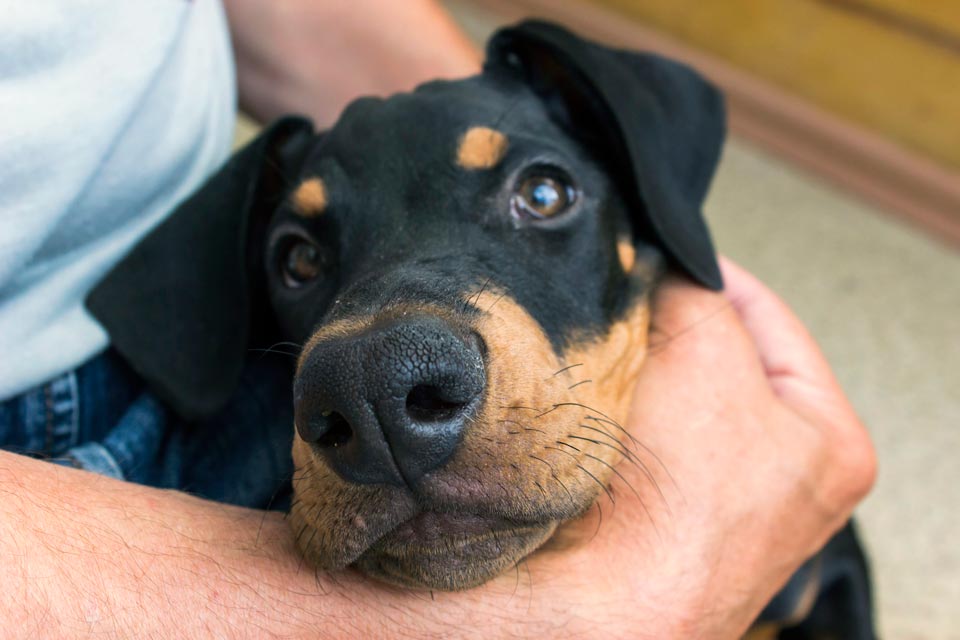Wobbler Syndrome in Dogs

Wobbler syndrome is the term used to describe a specific type of cervical (neck) vertebral instability in dogs. It occurs when there is compression of the last few vertebrae in the neck.
Cause of Wobbler Syndrome in Dogs
Wobbler can occur in two ways. The first is a disc-related condition that occurs mainly in large and giant breed dogs. This type occurs most often in older dogs and is caused by degeneration and herniation of discs in the neck.
The second is vertebrae-related Wobbler syndrome, and it occurs in young dogs. It has to do with misshapen or improperly articulating vertebrae (the bones in the spine).
In both cases, the spinal cord and nerve roots are compressed, and that leads to neurological signs.
Disc-related Wobbler is seen more commonly in Dobermans while Great Danes are prone to the vertebral-related type.
The exact mechanism or cause of the condition isn't known with certainty. Ideas that the disc-related form is related to nutritional deficiencies or fast growth haven't been borne out in studies.
Signs of Wobbler in Dogs
The signs of this condition can be quite variable depending on where in the spine the lesion is, how severe the compression is, and how long it's been going on. Some signs of Wobbler syndrome in dogs include:
- Neck pain
- Trouble standing from a lying or sitting position
- Loss of muscle in the front legs
- Worn toenails on the tops
- Wobbliness (ataxia) in all four limbs, especially the rears
Diagnosis of Wobbler Syndrome in Dogs
When a dog is showing signs of Wobbler, the doctor will also be considering other causes of disc or vertebrae problems. X-rays can show a narrowing of the space between vertebrae in the neck or strangely shaped vertebrae.
Myelography may help a veterinarian visualize the collapsed disc spaces and rule out other causes. It involves placing dye around the spinal cord and then doing fluoroscopy (x-rays in real time).
Treatment of Wobbler Syndrome in Dogs
Surgery to relieve pressure from leaked disc material and fuse the unstable vertebrae is the general treatment for Wobbler. If a dog is unable to walk, nursing care includes keeping him on a soft bed, turning him over periodically, and emptying his bladder manually or through a catheter.
Steroids are used to decrease swelling. If a dog is not going to have surgery, non-steroidal anti-inflammatory medications and strict rest may be useful, but the condition will most likely progress.
The earlier surgical intervention is pursued, the better the outcome in most cases, but some dogs that are treated surgically will have a recurrence of the condition.
You May Also Like These Articles:
IVDD: Intervertebral Disc Disease in Dogs
Springtime Hazards for Dogs - Slideshow
First Aid for Dogs: An Overview
Don't Ignore This Odd Canine Behavior: Head Pressing
Disclaimer: This website is not intended to replace professional consultation, diagnosis, or treatment by a licensed veterinarian. If you require any veterinary related advice, contact your veterinarian promptly. Information at DogHealth.com is exclusively of a general reference nature. Do not disregard veterinary advice or delay treatment as a result of accessing information at this site. Just Answer is an external service not affiliated with DogHealth.com.
Notice: Ask-a-Vet is an affiliated service for those who wish to speak with a veterinary professional about their pet's specific condition. Initially, a bot will ask questions to determine the general nature of your concern. Then, you will be transferred to a human. There is a charge for the service if you choose to connect to a veterinarian. Ask-a-Vet is not manned by the staff or owners of DogHealth.com, and the advice given should not delay or replace a visit to your veterinarian.



